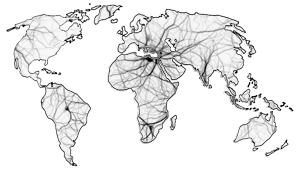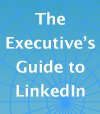Year in Review 2007—Editor’s Choice of the Global Human Capital Journal
 As I reflect on 2007 and create strategy for 2008, several macro-trends come into sharp relief, and I believe that some of them might be helpful to you as you conduct your own planning. As always, I focus on emerging phenomena because they are areas in which disruption and discontinuous change are acting on markets, thereby elevating threats and opportunities. Helping leaders to create strategy to manage the risk of unusual market developments is the focus of my consulting practice.
As I reflect on 2007 and create strategy for 2008, several macro-trends come into sharp relief, and I believe that some of them might be helpful to you as you conduct your own planning. As always, I focus on emerging phenomena because they are areas in which disruption and discontinuous change are acting on markets, thereby elevating threats and opportunities. Helping leaders to create strategy to manage the risk of unusual market developments is the focus of my consulting practice.
In 2007 it became clear to me that we were entering a profound social transformation that would produce an unimaginable degree of change. Unlike the technology-precipitated change that I’ve been helping people with since the 1990s, technology is shifting to the background now, and pervasive social change is taking the stage. Look for disruption in all areas affected by how people connect, communicate, purchase and collaborate: business, politics, community and leisure. Moreover, these changes are completely global with all the variations that engenders.
I can’t tell you how many acts this opera has, but 2007’s themes can provide you enough clarity, at a minimum, to notice that the water is getting warmer. I have also included among the links some prescriptive market advisories I wrote this year. They give explicit advice and action steps to maneuver your organization so that you can become stronger as these changes unfold.
![]() Thank you for your readership and support, and best regards as the curtain rises on the first act!
Thank you for your readership and support, and best regards as the curtain rises on the first act!
2007 Macro-Trends
Web 2.0 and Social Networking Appear on B2B Executives’ Radar Screens
 The adoption of new technologies and trends usually happens first among individuals and is subsequently retrofitted for the enterprise. Web 1.0 certainly followed this trend, with B2C e-commerce exciting consumers who went to work with changed expectations. They put increasing pressure on enterprise business partners (“if an online bookstore can give me real-time shipping information, why can’t you?”) and precipitated B2B e-business. Web 2.0 and social networks have been largely seen as idle curiosities by all but the most B2C-centric executives, but that began to change in 2007. During the fourth quarter, B2B executives from numerous industries began seeking me out to understand social networks because their clients began to ask them why they weren’t present in these venues. As I wrote in the Forrester Consumer Forum report, I predict that social networks will cross the “enterprise adoption” chasm in 2008. Most consumer-facing companies and brands will have to develop robust social network offerings to remain relevant, and B2B executives should create and execute strategies in 2008. The accelerating adoption of LinkedIn and Facebook by B2B executives in 2007 means that they are getting experience with these spaces and tools, which will change their expectations and drive further adoption in 2008-2010. For more, see:
The adoption of new technologies and trends usually happens first among individuals and is subsequently retrofitted for the enterprise. Web 1.0 certainly followed this trend, with B2C e-commerce exciting consumers who went to work with changed expectations. They put increasing pressure on enterprise business partners (“if an online bookstore can give me real-time shipping information, why can’t you?”) and precipitated B2B e-business. Web 2.0 and social networks have been largely seen as idle curiosities by all but the most B2C-centric executives, but that began to change in 2007. During the fourth quarter, B2B executives from numerous industries began seeking me out to understand social networks because their clients began to ask them why they weren’t present in these venues. As I wrote in the Forrester Consumer Forum report, I predict that social networks will cross the “enterprise adoption” chasm in 2008. Most consumer-facing companies and brands will have to develop robust social network offerings to remain relevant, and B2B executives should create and execute strategies in 2008. The accelerating adoption of LinkedIn and Facebook by B2B executives in 2007 means that they are getting experience with these spaces and tools, which will change their expectations and drive further adoption in 2008-2010. For more, see:
- Forrester Consumer Forum 2007 is a good place to get a broad overview of the strategic shifts being driven by social network and Web 2.0 adoption.
- How Social Tagging Changes the Economics of Ecommerce: Customers Help You to Boost Revenue—social tagging will be extremely powerful way to let customers help you to generate higher returns on your Web assets, externally and internally, and this article will explain how it works.
- Playboy’s Entrée into Social Networking and User-Generated Content shares Christie Hefner’s very insightful remarks about Playboy’s transformation.
Globalization Fades in Significance as It Becomes the Default, but New Twists Open Opportunities
 I clearly saw the context around “globalization” change significantly in 2007, and I wrote a short piece on the last day of the year, Globalization’s 21st Century Makeover. Simply put, globalization has become so common that it is banal. Successive generations of Internet-wired customers and companies have relegated globalization to the status of an implementation detail. By no means do I suggest that serving customers in various markets is simple; it’s just that customers and providers can find each other and transact business so easily that globalization’s distinctiveness as a concept has faded.
I clearly saw the context around “globalization” change significantly in 2007, and I wrote a short piece on the last day of the year, Globalization’s 21st Century Makeover. Simply put, globalization has become so common that it is banal. Successive generations of Internet-wired customers and companies have relegated globalization to the status of an implementation detail. By no means do I suggest that serving customers in various markets is simple; it’s just that customers and providers can find each other and transact business so easily that globalization’s distinctiveness as a concept has faded.
Now for the twists: it turns out that financial and knowledge capital are great equalizers, and companies in “emerging” countries like India and China are becoming global players with alacrity. Business and government leaders have developed the know-how and financial resources to radically change industries and become global players. This is ruffling feathers in “developed” (i.e. wealthy) countries as it rebalances economic power around the world.
- Globalization’s 21st Century Makeover offers a brief treatment of the significance of Tata Motors’ pending acquisition of Jaguar and Land Rover.
- Caterpillar CEO Pitches Free Trade Gauntlet to Business Leaders is James Owens’ impassioned plea for reason regarding international trade policy. The U.S. is at a turning point that will determine whether the country will regain its courage to compete, or retreat into protectionism and isolation.
- Leadership, Trust and the Globally Integrated Enterprise offers an excellent brief history of globalization as a phenomenon, and it analyzes IBM’s vision for the next generation enterprise.
- Knowledge Economy Learning examines how education and learning in developed countries need to be transformed. In most countries that were advanced in the Industrial Economy, assumptions and attitudes toward learning are hopelessly outdated, and leaders need to transform learning to compete effectively in the Knowledge Economy.
Corporate Innovation Pressured by Consumer Empowerment
 As I wrote and spoke about all year, companies must innovate to create sustainable value in the Knowledge Economy because the Industrial Economy value engine—efficiency/economy of scale—no longer creates enduring value in most industries. This is a permanent shift that has caught most leaders off guard. Innovation, because it inherently involves discontinuous change, is the enemy of the efficient organization, which prefers continuous processes. Companies that recognize innovation as the Knowledge Economy DNA will prevail, but this means transforming innovation’s role in the company. I predict that innovation will increasingly be led by customers. Yes, you read that right:
As I wrote and spoke about all year, companies must innovate to create sustainable value in the Knowledge Economy because the Industrial Economy value engine—efficiency/economy of scale—no longer creates enduring value in most industries. This is a permanent shift that has caught most leaders off guard. Innovation, because it inherently involves discontinuous change, is the enemy of the efficient organization, which prefers continuous processes. Companies that recognize innovation as the Knowledge Economy DNA will prevail, but this means transforming innovation’s role in the company. I predict that innovation will increasingly be led by customers. Yes, you read that right:
- My review of Innovate Like Edison: The Success System of America’s Greatest Inventor offers a glimpse into an excellent guidebook for increasing your innovation literacy and technique.
- Always in Beta: How big Business Can Benefit from “Little” Innovation chronicles a fantastic session with visionaries at Procter & Gamble and Dell at Forrester Consumer Forum. It highlights their pragmatic advice for making corporate innovation (no, not necessarily an oxymoron) work.
- In Rebooting Kraft—CEO Outlines Growth Strategy at Executives’ Club, I explain how CPGs are trapped in legacy production and distribution paradigms, and I offer some ideas for transitioning to the Knowledge Economy through customer-led innovation.
- For contrast, read about how Apple is successfully transforming itself in Reading between the Lines: Apple’s New Business Strategy.
- Don’t miss my review of Patty Seybold’s excellent latest book, Outside Innovation: How Your Customers Will Co-design Your Company’s Future.
The Environment Resurfaces as a Huge Innovation Wave
 During 2007, it became quite obvious that humankind would have to change the rules with respect to our impact on the earth. There are two major threads: first, increasing wealth is exploding demand for natural resources, which is serving to drive up costs to almost unprecedented levels. Since wealth and demand are increasing and natural resources are in relative finite supply, prices and costs will increase, increasing the threat of strife and war. Second, and even more daunting, is the carbon issue which appears to be even more change-inducing. For what it’s worth, Silicon Valley has been buzzing with environmental ventures for the past few years, but this year green venturing went positively mainstream. If we’re going to have to change our lifestyles, why not let the market flush out solutions? These developments confront us with fundamentally changing our outlook—from the prevailing zero-sum winner take all mentality to a more collaborative approach. For further reading, see:
During 2007, it became quite obvious that humankind would have to change the rules with respect to our impact on the earth. There are two major threads: first, increasing wealth is exploding demand for natural resources, which is serving to drive up costs to almost unprecedented levels. Since wealth and demand are increasing and natural resources are in relative finite supply, prices and costs will increase, increasing the threat of strife and war. Second, and even more daunting, is the carbon issue which appears to be even more change-inducing. For what it’s worth, Silicon Valley has been buzzing with environmental ventures for the past few years, but this year green venturing went positively mainstream. If we’re going to have to change our lifestyles, why not let the market flush out solutions? These developments confront us with fundamentally changing our outlook—from the prevailing zero-sum winner take all mentality to a more collaborative approach. For further reading, see:
- Noodle II: Tackling the Intractable Problem of the Automobile reports on two exciting developments for changing the rules.
- Will China’s Rise Lead to an Environmental Catastrophe? directly addresses both the global environmental impact of China’s growth as well as how it is confronting the nation state.
The Transformation of Communications and Advertising Accelerates
![]() Now so trite that it became a joke, Time Magazine’s “2006 Person of the Year” was the consumer (“you”). There was increasing recognition that so-called “user-generated” content was interfering with marketers’ finely crafted messaging. It turns out that consumers often prefer to learn about the world from each other as much as—or even more than—from experts and company representatives. This poses an interesting opportunity/threat scenario for marketers and the advertising and communications business. On one hand, they are being disintermediated by their customers, and they struggle for relevance. On the other hand, customers are giving each other useful information that can drive demand—at minimal variable cost to companies:
Now so trite that it became a joke, Time Magazine’s “2006 Person of the Year” was the consumer (“you”). There was increasing recognition that so-called “user-generated” content was interfering with marketers’ finely crafted messaging. It turns out that consumers often prefer to learn about the world from each other as much as—or even more than—from experts and company representatives. This poses an interesting opportunity/threat scenario for marketers and the advertising and communications business. On one hand, they are being disintermediated by their customers, and they struggle for relevance. On the other hand, customers are giving each other useful information that can drive demand—at minimal variable cost to companies:
- Charting a New Course: Communicating in a Digital Age
addresses the P2P world in which individuals communicate pervasively with individuals, and what this represents for media companies, their clients and everyone’s customers. - Advertising NEXT: Social Networks, User Generated Video, Blogs, IMs, Podcasts, Broadband and Mobile identifies and evaluates major trends and pressures felt by agencies.
- Advertising and Technology: Emerging Capabilities in Interactive TV, Broadband, UGM & Mobile focuses on some of the emerging technologies’ potential impacts on the business.
- Reinventing Advertising: Broadcast vs. the New Platforms: VOD, PVR, Broadband & Mobile explicitly tackles how advertising can reinvent itself to deliver more value in the ages of user-generated content and pervasive mobility.
Enterprise 2.0: The Ongoing Transformation of the Enterprise and IT
 As long-time readers will attest, my focus has always been enterprise transformation, so this topic was well represented in 2007’s coverage. Web 1.0 (loosely, “the Internet” boom) introduced a standard way for individuals to interface to enterprise content over the pervasive network (Internet). “Web 2.0” shifts the focus to peer-to-peer interactivity, which is beginning to exert pressure on CIOs, CMOs and IT. In 2007, right on schedule, industry pundits and analysts invented a new buzzword for applying Web 2.0 to the enterprise, “Enterprise 2.0.” I covered enterprise transformation from several perspectives:
As long-time readers will attest, my focus has always been enterprise transformation, so this topic was well represented in 2007’s coverage. Web 1.0 (loosely, “the Internet” boom) introduced a standard way for individuals to interface to enterprise content over the pervasive network (Internet). “Web 2.0” shifts the focus to peer-to-peer interactivity, which is beginning to exert pressure on CIOs, CMOs and IT. In 2007, right on schedule, industry pundits and analysts invented a new buzzword for applying Web 2.0 to the enterprise, “Enterprise 2.0.” I covered enterprise transformation from several perspectives:
- A speaker at FMW’s Enterprise 2.0 in Capital Markets conference, I caught several sessions and contributed this report which describes enterprise 2.0’s impact on capital markets and investment banking.
- Enterprise 2.0: Game-Changer for Investment Banks is a more analytical and prescriptive treatment that offers CEO and CIO action steps for 2007-2008.
- Innovation Defines New CIO Role at “Networked Economy 2.0” Conference delves into the CIO’s role in preparing the enterprise to engage customers in the Web 2.0 world.
- Cisco CEO Shares Impressive M&A Collaboration Story describes Cisco’s results with using wikis for mergers & acquisitions.
Marketing 2.0: The Opportunity of a Generation for Marketing Executives—Other Changing Roles
 Having spent half of my career as a marketing executive and the other half as a management consultant, I am astounded at how Web 2.0 is upping the stakes for marketers. Web 2.0 and social networks completely change the context of marketing because they digitize and actualize word of mouth marketing for the first time. The marketing function is steadily becoming a shadow of its former self, but marketers that understand the dynamics will produce unprecedented value, while those that can’t morph will increasingly struggle.
Having spent half of my career as a marketing executive and the other half as a management consultant, I am astounded at how Web 2.0 is upping the stakes for marketers. Web 2.0 and social networks completely change the context of marketing because they digitize and actualize word of mouth marketing for the first time. The marketing function is steadily becoming a shadow of its former self, but marketers that understand the dynamics will produce unprecedented value, while those that can’t morph will increasingly struggle.
That’s not all. As I explain in Web 2.0 and Social Networks—The Transformation of Relationships, we are exiting the stage of technology-led transformation. Web 2.0, because it connects individuals(customers), recasts I.T. into the role of “best supporting actor.” In terms of traditional enterprise functions, marketing will have the starring role because it is concerned with understanding customers. But marketers risk doing more harm than good if they don’t appreciate the things that have changed.
- Web 2.0 and Social Networks—The Transformation of Relationships is a short introduction.
- Web 2.0 Means Marketing 2.0 discusses how astute marketers can enlist customers’ help to build their companies’ cred and popularity.
- Consumer Empowerment—A Rare Innovation Opportunity is a prescriptive market advisory offering senior executives recommended action steps for 2007-2008.
- Virtual Worlds and Gaming: Fertile Ground for Real Relationships provides basic guidance for understanding virtual worlds like Second Life and how they are adding to the marketing mix.
The Surprise of the Year.. My “Unofficial” Guide to LinkedIn was #1 on Google All Year!
 In early 2007, I bench tested LinkedIn and found its privacy controls impressive and completely sufficient for earning the trust of enterprise executives and professionals. A new enthusiast, I quickly found that the very business people who could benefit the most from LinkedIn did not understand it. As a service, I published a review of LinkedIn as well as the “Unofficial” Guide, which went number one within days of publication thanks to supporters around the world:
In early 2007, I bench tested LinkedIn and found its privacy controls impressive and completely sufficient for earning the trust of enterprise executives and professionals. A new enthusiast, I quickly found that the very business people who could benefit the most from LinkedIn did not understand it. As a service, I published a review of LinkedIn as well as the “Unofficial” Guide, which went number one within days of publication thanks to supporters around the world:
- The Global Human Capital Journal Unveils Review and “Unofficial” Executive Guide to LinkedIn is a news release and executive summary that summarizes each of the long posts and describes how they work together.
- Site Review/LinkedIn: A Vastly Underutilized Resource for Executives and Professionals helps people assess whether LinkedIn could be useful, and it explains privacy controls and key functionality.
- The Unofficial LinkedIn User’s Guide for Executives and Professionals gives strategies and additional resources for using LinkedIn. One of the first resources to explicitly address ROI.
- The Executive’s Guide to LinkedIn website is not a part of the Global human Capital Journal, but it includes presentations and other resources.
Developments at the Global Human Capital Journal
If you made it this far, you can see that 2007 was a blockbuster year for the Global Human Capital Journal. Here is a summary of key developments:
|

[…] collaboration by facilitating their adoption of social networks and Web 2.0. As predicted in the Year in Review—2007, social networks and Web 2.0 are being embraced in the enterprise B2B arena this year, and this […]